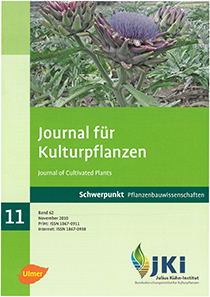Grain legumes in mixed stands with false flax (<em>Camelina sativa</em>) in organic farming under Pannonian site conditions
DOI:
https://doi.org/10.5073/JfK.2010.11.02Keywords:
Mixing ratio, lens, grass pea, field pea, yieldAbstract
The grain legumes lens (Lens culinaris), grass pea (Lathyrus sativus) and field pea (Pisum sativum) were examined as pure crops and in different mixing ratios with false flax (Camelina sativa) on organically cultivated fields of the University of Natural Resources and Life Sciences, Vienna, in the Pannonian region in three consecutive vegetation periods. The aim of this study was to test whether a mixed stand of grain legume and false flax shows advantages compared to the pure crops despite an increased competition between the partners in the mixture under the dry conditions. Therefore, the optimum seed density for the partners in the mixed stand under the Pannonian conditions was identified. The weather conditions varied widely within the three vegetation periods and influenced the yield of the mixtures. Under the favourable weather conditions in the first experimental year, the mixed stands of lens-false flax and grass pea-false flax showed benefits in yield. On average across three very different years, a mixture of false flax : lens at 25:75 percent had the most positive mixture cropping effect. An average of 0.6 t ha–1 false flax was achieved in mixed stands with lentils and in mixtures with grass pea and field pea with high false flax percentage. In general, the positive effect of the substitutive lens-false flax and grass pea-false flax mixed stands was higher in the favourable, wet years than the negative effect in the unfavourable, dry year. We therefore recommend these grain legume-false flax mixed stands for the dry regions in Eastern Austria and for climatically similar regions in Hungary or Central Germany.
Downloads
Published
Issue
Section
License
The content of the journal is licensed under the Creative Commons Attribution 4.0 License. Any user is free to share and adapt (remix, transform, build upon) the content as long as the original publication is attributed (authors, title, year, journal, issue, pages).
The copyright of the published work remains with the authors. The authors grant the Journal of Cultivated Plants, the Julius Kühn-Institut and the OpenAgrar repository the non-exclusive right to distribute and exploit the work.







